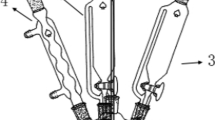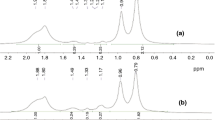Abstract
The zinc ion self-crosslinkable polyacrylate latexes (PAs) cured at room temperature were synthesized by seeded semi-continuous emulsion polymerization with zinc oxide (ZnO) as crosslinker. The ZnO and methacrylic acid (MAA) mass contents, method of ZnO introduction in relation to the degree of crosslinking, and the properties of self-crosslinkable latices are examined and discussed. The characterization techniques such as Fourier transform infrared spectroscopy (FTIR), differential scanning calorimeter (DSC), transmission electron microscopy (TEM), and thermal gravimetric analysis (TGA) have been used to determine the structure and properties of PAs. The experimental results show that in a certain range, the average particle size decreases with an increase in the content of MAA, while the latex stability is undoubtedly improved. The optimum mass content of MAA is 12 % of the total monomers. The optimum amount of ZnO needed is 25 % (mole fraction) of MAA, and the optimum temperature of ZnO introduction is 60 °C. TEM analyses show that the latex particles are coarse spherical particles with surface enriched with comprising abundant carboxyl groups, and zinc ions are dissociated as zinc ammine complex in the aqueous phase. FTIR analyses confirm that the chelate crosslinking occurs between zinc ions and carboxylic acid during the film-forming process. The DSC results indicate that the glass transition temperature (T g) of PAs increases as a function of the formation of a coordinate structure, and the obtained film exhibits excellent initial hardness and sandability. TGA analyses demonstrate that the introduction of ZnO evidently enhances the thermal stability of self-crosslinkable PAs.










Similar content being viewed by others
References
Kahraman A, Sarac A (2011) Electrical, film and surface properties of water-based latexes prepared by semi-continuous emulsion polymerization. Polym React Eng 302:266–272
Steward PA, Hearn J, Wilkinson MC (2000) An overview of polymer latex film formation and properties. Adv Colloid Interf 86:195–267
Roland F, Michael GDI (2007) New waterborne cationic binders for primer applications. Paintindia 57:97–104
Soleimani M, Haley JC, Majonis D, Guerin G, Lau W, Winnik MA (2011) Smart polymer nanoparticles designed for environmentally compliant coatings. J Am Chem Soc 133:11299–11307
Schneider M, Graillat C, Guyot A, Mckenna TF (2002) High solid content emulsion. Part II: Preparation of seed latexes. J Appl Polym Sci 84:1897–1914
Nakayama Y (2004) Development of novel aqueous coatings which meet the requirements of ecology-conscious society: novel cross-linking system based on the carbonyl–hydrazide reaction and its applications. Prog Org Coat 51:280–299
Joshi RG, Provder T, Ziemer P, Mao W, Shen W, Jones FN (2009) Investigation of the effect of precoalescence or postcoalescence cross-linking on film formation, properties, and latex morphology. J Coat Technol 6:47–65
Volfova P, Chrastova V, Cernakova L, Mrenica J, Kozankova J (2001) Properties of polystyrene/poly(butyl acrylate) core/shell polymers modified with N-methylol acrylamide. Macromol Symp 170:283–290
Tamai T, Watanabe M (2006) Acrylic polymer/silica hybrids prepared by emulsifier-free emulsion polymerization and the sol-gel process. J Polym Sci 44:273–280
Zhang B, Liu B, Deng X, Cao S, Hou X, Chen H (2007) A novel approach for the preparation of organic-siloxane oligomers and the creation of hydrophobic surface. Appl Surf Sci 254:452–458
Suegama PH, Melo HG, Benedetti AV, Aoki IV (2009) Influence of cerium (IV) ions on the mechanism of organosilane polymerization and on the improvement of its barrier properties. Electrochim Acta 54:2655–2662
Tadanok K, Hirasawa E, Yamamoto H (1989) Order-disorder transition of ionic clusters in ionomers. Macromolecules 22:226–233
Anderson AG, Mahler W (2010) Aqueous dispersions containing ionomer resins and rust-preventive ionomeric coatings made therefrom. US P 7,816,458
Waterman P, Godbout M (2009) Prime coat, indicia and clear coat removal process for a golf ball. US P 7,614,407
Kasperchik VP, Kwasny DM (2009) Protective overcoat on inkjet and xerographic images. EP 1,205,809
Liu XH, Zhang CZ, Xiong T (2007) Rheological and curing behavior of aqueous ambient self-cross-linkable polyacrylate emulsion. J Appl Polym Sci 106:1448–1455
Lai JZ, Ling HJ, Chen GN, Yeh JT, Chen KN (2004) New self-curable aqueous-based polyurethane system by an isophorone diisocyanate/uretedione aziridinyl derivative process. J Appl Polym Sci 94:845–859
Michael OJ, Richard GT (1990) Cross-linked polymeric product, a process for producing said product and aqueous compositions comprising said product. EP 0,373,918
Ishioka T, Shimizu M, Watanabe I (2000) Infrared and XAFS study on internal structural change of ion aggregate in a zinc salt of poly(ethylene-co-methacrylic acid) ionomer on water absorption. Macromolecules 33:2722–2727
Neppel A, Butler LS, Eisenberg A (1979) Vibrational spectra of polymers. 2. Variable-temperature Raman spectroscopy as a probe for ion clustering in ionomers. Macromolecules 12:948–952
Moore RB, Bittencourt D, Gauthier M, Williams CE, Eisenberg A (1991) Small-angle X-ray scattering investigations of ionomers with variable-length side chains. Macromolecules 24:1376–1382
Tsagaropoulos G, Kim JS, Eisenberg A (1996) Chain mobility restrictions in random ionomers studied by electron spin resonance spectroscopy. Macromolecules 29:2222–2228
Nishida M, Eisenberg A (1996) Dynamic mechanical study of sodium sulfonated random ionomers based on hydrogenated styrene−butadiene copolymer. Macromolecules 29:1507–1515
Acknowledgments
Financial support from the National Natural Science Foundation of China (No. 50803017) is greatly appreciated.
Author information
Authors and Affiliations
Corresponding author
Rights and permissions
About this article
Cite this article
Yan, W., Zhang, X., Zhu, Y. et al. Synthesis and characterization of self-crosslinkable zinc polyacrylate latices at room temperature. Iran Polym J 21, 631–639 (2012). https://doi.org/10.1007/s13726-012-0068-4
Received:
Accepted:
Published:
Issue Date:
DOI: https://doi.org/10.1007/s13726-012-0068-4




